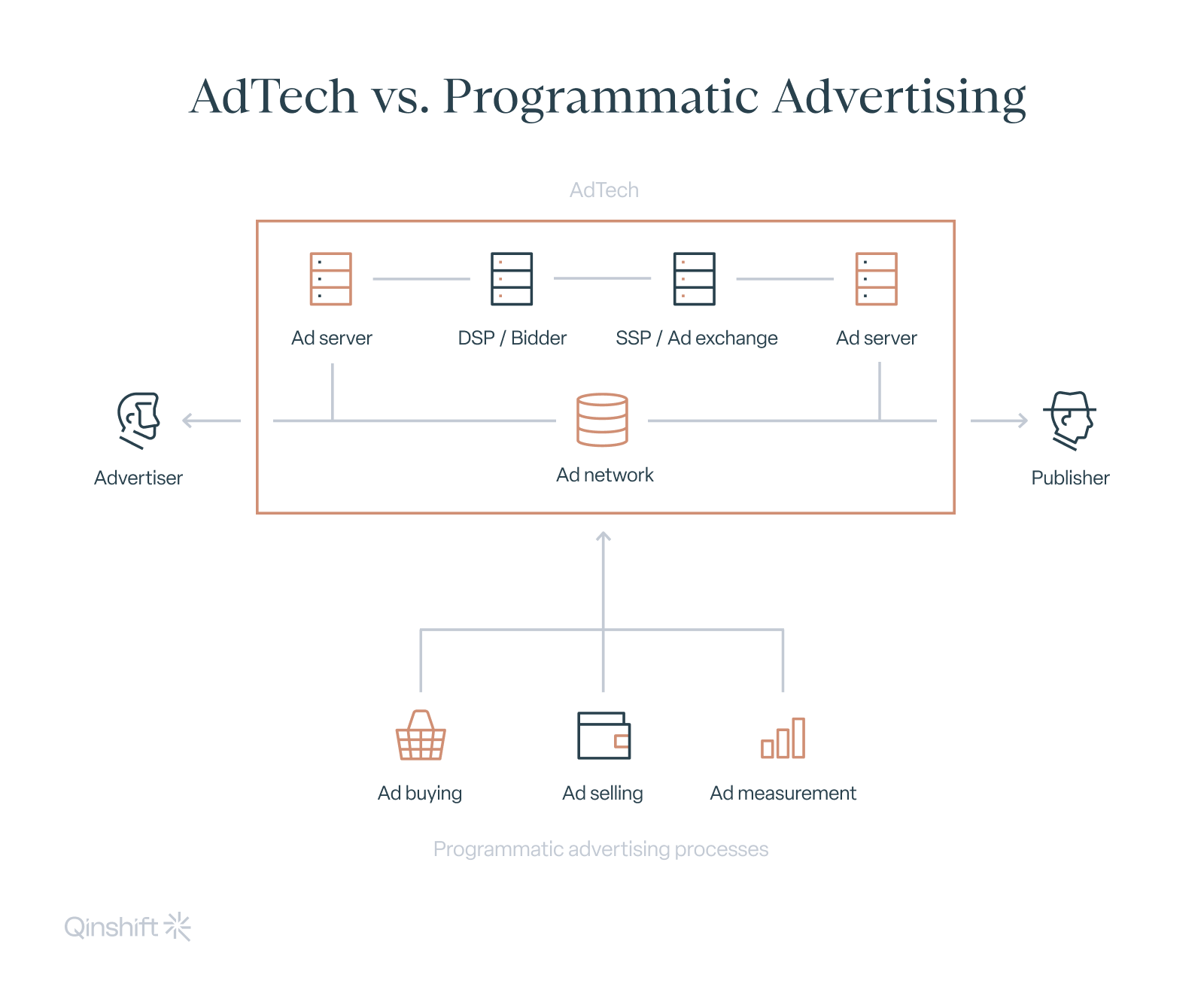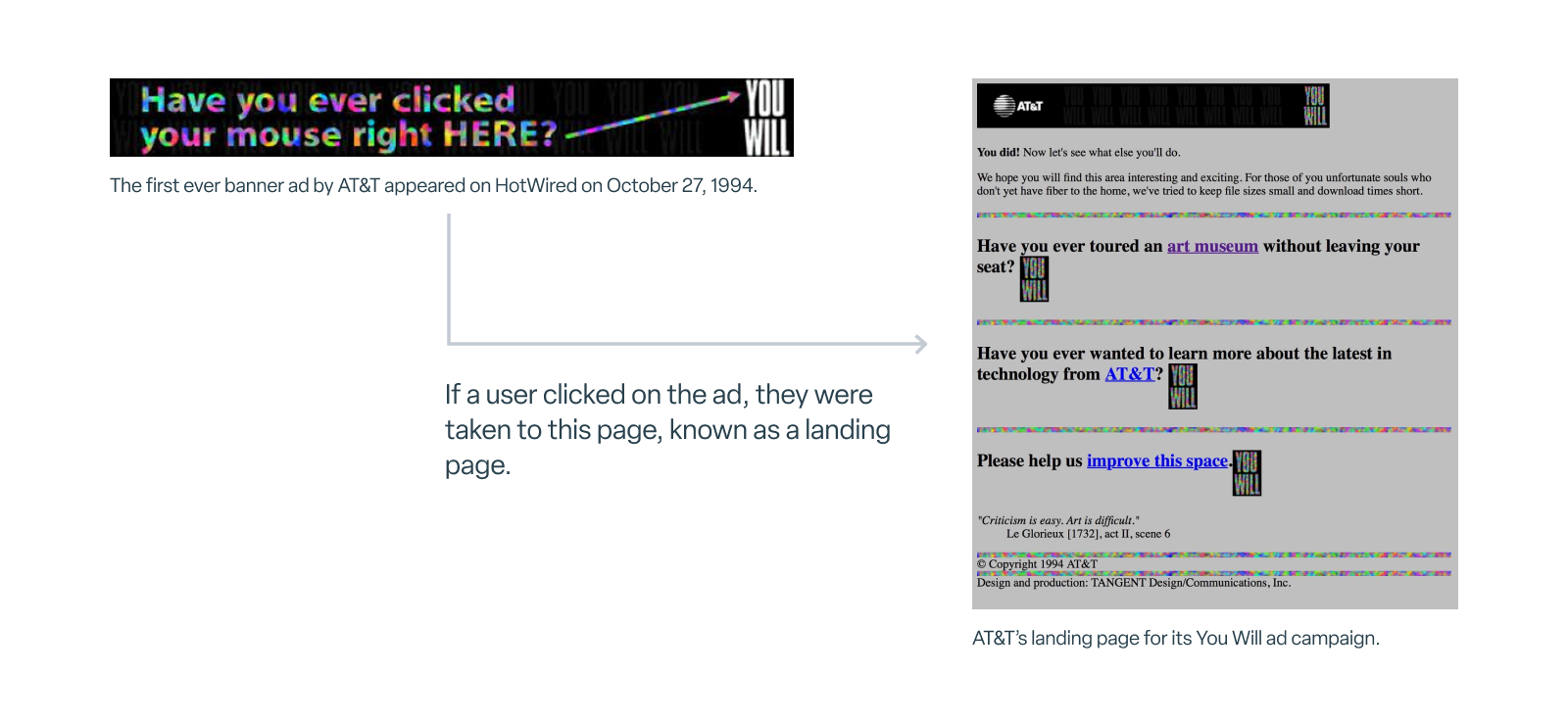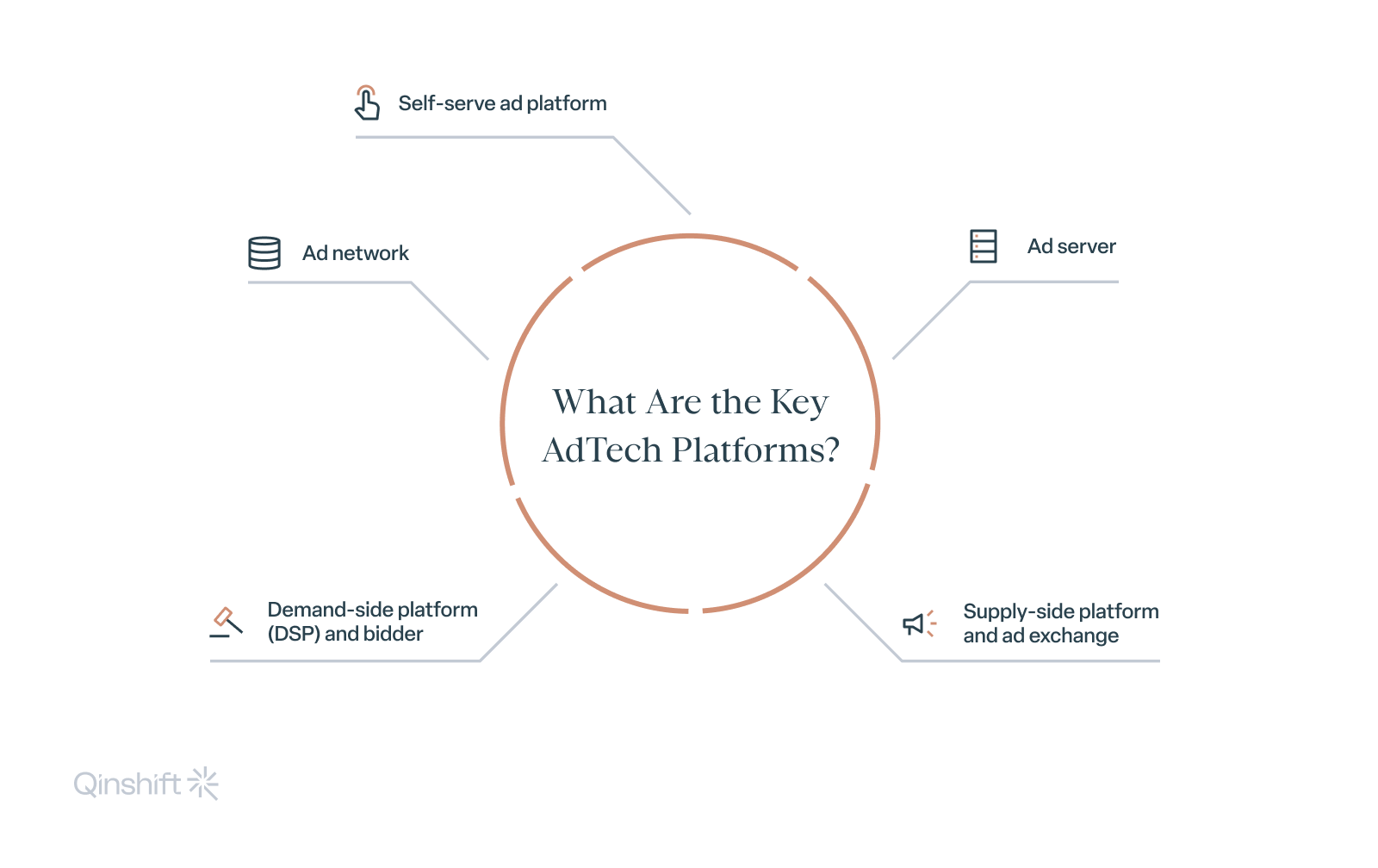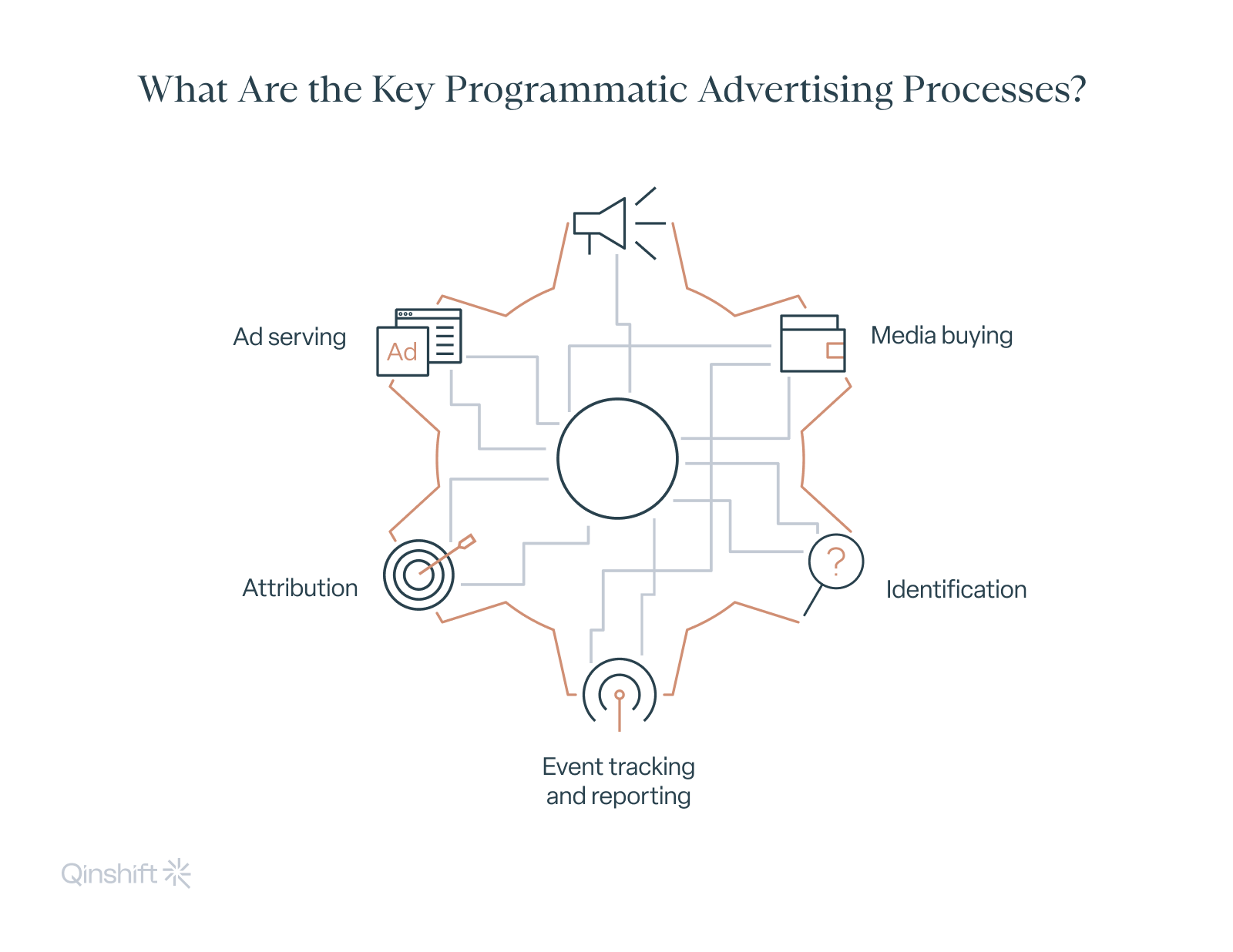What Is AdTech and Programmatic Advertising?

Global digital ad spend is estimated to reach $740 billion in 2024, up $61 billion from the previous year. At the heart of all of this is one key thing: software.
The software used to facilitate the various digital advertising processes is known as advertising technology (AdTech).
In this article, you’ll learn:
-
What is AdTech?
-
Who are the key players in AdTech?
-
How does programmatic advertising work?
Key Takeaways
-
AdTech is short for “advertising technology” and refers to the software used to power the technical processes in programmatic advertising.
-
Programmatic advertising is an umbrella term that represents the various technical processes used to buy, sell, deliver, and measure digital advertising.
-
“Programmatic advertising” refers to the automation of key advertising processes and “AdTech” refers to the software used to carry out these processes.
-
AdTech and programmatic advertising began in the mid-1990s, when online advertising first started to take off.
-
The key AdTech platforms are: ad servers, ad networks, demand-side platforms (DSPs), supply-side platforms (SSPs), self-serve ad platforms, and data platforms like data management platforms (DMPs), customer data platforms (CDPs), and data clean rooms.
-
The key programmatic advertising processes are: ad serving, real-time bidding, header bidding, event tracking and reporting, and attribution.
What Is AdTech?
AdTech is short for “advertising technology” and refers to the software used to power the technical processes in programmatic advertising. There are many different types of AdTech platforms and each plays its own role in facilitating the buying, selling, and measurement of digital media.
You’ll often hear words like “AdTech platform” and “AdTech tools”, which all mean the same thing: software.
What Is Programmatic Advertising?
Programmatic advertising is an umbrella term that represents the various technical processes used to buy, sell, deliver, and measure digital advertising. The word “programmatic” simply means “automation”, with the automation aspect being carried out via AdTech platforms.
What’s the Difference Between AdTech and Programmatic Advertising?
Advertising technology (AdTech) refers to the software used to power the various programmatic advertising processes in digital advertising, whereas programmatic advertising refers to the automation of the various processes used to buy, sell, deliver, and measure digital advertising.
Essentially, “programmatic advertising” refers to the automation of key advertising processes and “AdTech” refers to the software used to carry out these processes.

When Did AdTech and Programmatic Advertising Begin?
In the early 1990s, many companies and internet enthusiasts started creating the first public websites. Advertisers identified the potential opportunities this new channel had to offer and on October 27, 1994, AT&T published the first ever online ad on HotWired (now wired.com).

Image on the left: The first ever banner ad by AT&T appeared on HotWired on October 27, 1994.
Image on the right: AT&T’s landing page for its You Will ad campaign
In the very early days of online advertising, everything was done manually. Advertisers would email their ad tags to the websites’ sales teams, who would then manually add them to their websites.
When the first AdTech platforms — mainly ad server and ad networks — emerged in the mid-to-late 1990s, the concept of programmatic advertising was born. In the following years, various new types of AdTech platforms were introduced as online advertising evolved and grew.
Who Are the Key Players in Programmatic Advertising?
Advertisers
An advertiser is any company that wants to promote their products or services to their target audience. An advertiser could be an individual brand or an advertising agency representing multiple brands.
It’s very common that a company will act as both an advertiser and an ad inventory owner.
For example, the Financial Times will often run ad campaigns across different advertising channels to attract new readers. In this context, they are classed as an advertiser. However, the Financial Times will also display ads on their website to monetise their content and audiences, which in this context classifies them as an inventory owner.
Ad Inventory Owners
An ad inventory owner is an umbrella term for any company that attracts an audience. The term inventory refers to the total amount of ad space a company has to offer to advertisers.
In the context of websites, inventory owners are often referred to as publishers. However, ad inventory owners can also include mobile apps, streaming services like Netflix, and digital out-of-home (DOOH) screen operators.
Essentially, any company that has access to an audience that advertisers want to reach can be classified as an ad inventory owner.
AdTech Vendors
The companies that provide software to advertisers and ad inventory owners to help them buy, sell, deliver, and measure their ad campaigns are known as AdTech vendors.
There are thousands of different AdTech vendors on the market, with many of them offering different types of software to advertisers and ad inventory owners for different digital advertising channels, e.g. web advertising, in-app mobile advertising, retail media, and CTV advertising.
Data Vendors
Apart from the AdTech vendors, there are also companies that provide data platforms to help advertisers and ad inventory owners collect, store, manage, and use the data they collect from their users, customers, and digital properties — e.g. websites and mobile apps.
Data plays a key role in programmatic advertising, as it allows advertisers and ad inventory owners to improve ad targeting, measurement, and attribution.
The key data platforms used in programmatic advertising include data management platforms (DMPs), customer data platforms (CDPs), and data clean rooms.
What Are the Key AdTech Platforms?

Ad Server
An ad server is used by advertisers to create, manage, and run digital advertising campaigns across multiple websites, mobile apps, and other digital advertising channels.
One of the key roles of an ad server is to decide which ad to show on a website or mobile app, as well as facilitate the delivery process between the advertiser and publisher.
Ad inventory owners, such as websites and mobile app developers, can also use an ad server to manage and sell their ad inventory to multiple advertisers.
Ad servers, for both advertisers and ad inventory owners, can also collect and report on the performance of ad campaigns. These reports will tell advertisers and publishers how many impressions (individual ad views), clicks, and conversions a given ad campaign generated.
There are two main types of ad servers:
1. A publisher’s ad server, also known as a first-party ad server.
2. An advertiser’s ad server, also known as a third-party ad server.
See the Ad Serving section below for more information about the difference between these two types of ad servers.
Ad Network
This AdTech platform acts as a broker between advertisers and ad inventory owners. Ad networks were one of the first AdTech platforms to emerge when online advertising began in the mid-1990s and are still used today.
Ad networks allow advertisers to show ads to audiences across multiple websites and mobile apps. For example, an ad network that operates in the fashion vertical would gather ad inventory from a range of fashion-oriented websites and sell it to fashion brands (a.k.a. advertisers).
Demand-Side Platform (DSP) and Bidder
A demand-side platform (DSP) is a media-buying platform used by advertisers to purchase individual impressions. Compared to ad networks that allow advertisers to purchase ad impressions in bulk, DSPs allow advertisers to show one ad to one user across any website or mobile app.
The process of buying individual impressions is carried out via real-time bidding (RTB) auctions.
A key component of a DSP is a bidder, which is responsible for receiving bid requests from SSPs and ad exchanges, and matching it with the ad campaigns created by advertisers.
Supply-Side Platform (SSP) and Ad Exchange
An SSP is a media-selling platform used by ad inventory owners to sell individual ad impressions to advertisers. Essentially, an SSP is to ad inventory owners what a DSP is to advertisers.
SSPs help websites and mobile apps offer their ad inventory to thousands of advertisers via demand-side platforms (DSPs). A key component of an SSP is an ad exchange, which facilitates the buying and selling of individual impressions via real-time bidding auctions.
In the past, SSPs and ad exchanges often operated as separate platforms. However, these two platforms now operate as a single one, allowing companies to manage their ad inventory and also sell it to advertisers via DSPs.
Self-Serve Ad Platform
There are two main types of self-serve ad platforms. The first type is integrated into an existing media-buying platform, such as a DSP, and allows advertisers to create, run, and manage advertising campaigns themselves, instead of having the campaigns created for them by the AdTech company’s AdOps team. The latter is referred to as the managed-service model.
The second type of self-serve ad platform is used by ad inventory owners to give advertisers direct access to their audience and allow them to run ad campaigns on their digital properties, e.g. website, mobile app, ecommerce store, or streaming service. The key advantage of this approach is that advertisers can directly reach a specific audience, without the ad inventory owner having to share any user-level data with the advertisers.
One example of a self-serve ad platform is Facebook Ads. Advertisers can create ad campaigns and run them on Facebook, but Facebook doesn’t share any data or information about their users with advertisers.
What Are the Key Programmatic Advertising Processes?

Ad Serving
Ad serving refers to the process of displaying an ad on a website, mobile app, etc., and reporting on its performance.
A publisher’s ad server is responsible for managing the ad slots on their websites and mobile apps, serving ads from direct campaigns, managing other campaigns (e.g. real-time bidding), and reporting on the performance of the ads (e.g. impressions and clicks).
An advertiser’s ad server is responsible for managing the creatives, sending ads to inventory owners, and collecting data about the performance of their campaigns.
Media Buying
There are many different ways advertisers can buy ad space from ad inventory owners.
Some of the main ways include:
-
Programmatic direct, which involves an ad inventory owner selling ad space directly to advertisers via an AdTech platform, e.g. an ad server.
-
Real-time bidding (RTB), a process where individual impressions are bought and sold via a real-time auction between bidders and ad exchanges.
-
Header bidding, a process that enables ad inventory owners, e.g. websites, to simultaneously gather bids from a number of demand sources (e.g. DSPs) before their ad server loads other ad monetisation opportunities, such as direct deals.
Identification
In order for advertisers to show ads to their target audience, they first need to identify whether a given person visiting a website, using a mobile app, or watching a movie on a streaming service is a member of their target audience.
They do this by utilising various identification methods. These identification methods can include web cookies (e.g. first- and third-party cookies), IP addresses, universal ID solutions, and mobile IDs.
With the end of third-party cookies in web browsers and the increasing focus on improving user privacy in advertising, many 1-to-1 identification processes are being replaced with more privacy-friendly solutions, such as Google Chrome’s Privacy Sandbox and data clean rooms.
Event Tracking and Reporting
AdTech platforms collect data from ad campaigns, so that advertisers and ad inventory owners can view detailed reports about the performance of their campaigns.
There are a number of different events that AdTech platforms track, including ad impressions, clicks and conversions, as well as ad viewability and ad-exposure time.
This data not only helps advertisers measure the performance of their campaigns, but also aids them with planning future campaigns.
Attribution
In order to understand how their customers are buying their products or services, advertisers use various attribution models to identify which touchpoints a person interacted with or was exposed to before they completed a goal, e.g. purchased a product online.
Final Thoughts on AdTech and Programmatic Advertising
Thank you for reading our article on AdTech and programmatic advertising.
We hope it’s helped you gain a better understanding of this crucial aspect of digital advertising.
If there’s anything we can do for you, feel free to leave us a message and expect a reply soon!
Looking for AdTech & MarTech development services?
Discover how our teams can help you design, build and maintain advertising and marketing software.
